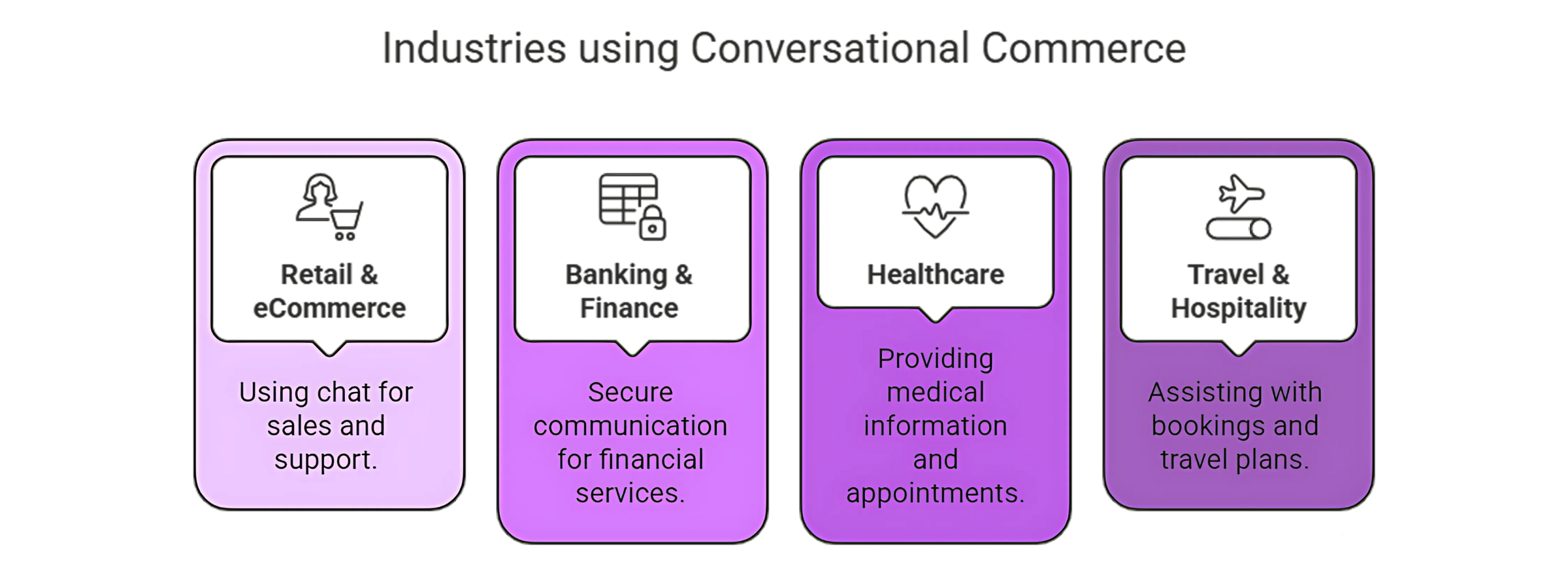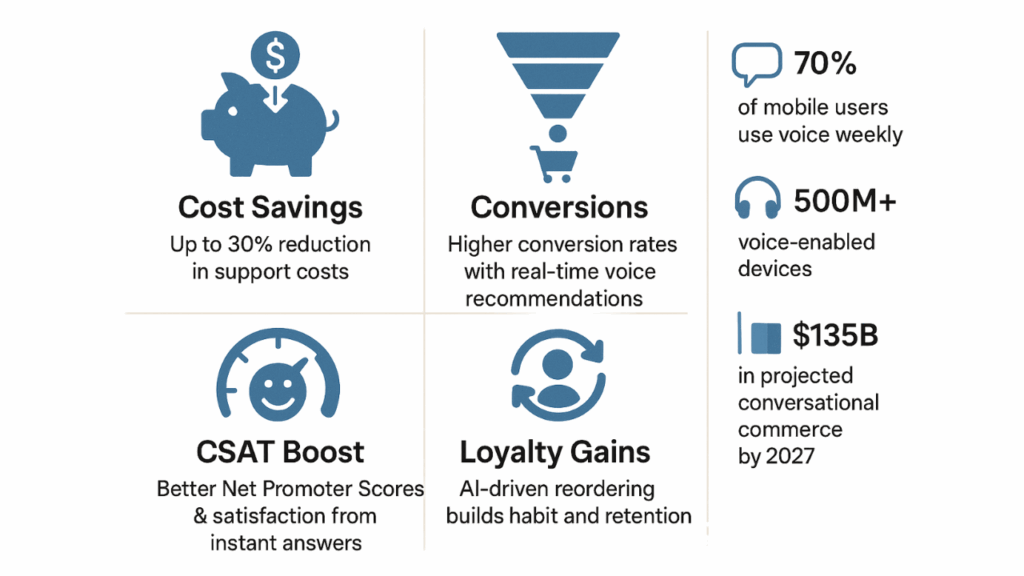Voice search and conversational commerce aren’t just buzzwords, they’re a shift in how consumers discover, evaluate, and purchase products. With AI at the core, businesses are reimagining shopping experiences that feel less like transactions and more like conversations. From smart speakers and virtual assistants to chatbots and voice-enabled mobile apps, the way customers interact with brands is becoming more intuitive and responsive.
In this article, we explore how AI is driving the adoption of voice and conversational interfaces, why it matters for eCommerce businesses, and how it impacts search, conversion, and long-term brand loyalty.
Understanding the Shift to Conversational Commerce
Conversational commerce refers to digital shopping experiences that use real-time dialogue between the consumer and brand, whether via chat, voice, or AI-powered assistants. And it’s growing fast. According to a report by Juniper Research, the value of transactions via conversational commerce channels will reach $135 billion globally by 2027, up from $39 billion in 2023.
The surge in voice technology is part of this broader evolution. With over 500 million voice-enabled devices in use globally and more than 70% of mobile users relying on voice assistants weekly, voice search is no longer niche, it’s mainstream.
But why is this important? Because AI-powered conversational tools remove friction. Shoppers can ask, explore, compare, and buy, all without clicking, typing, or waiting. The result is speed, convenience, and a more natural path to purchase.
Voice Search: Reshaping How People Discover Products
Voice search is fundamentally different from text search. Instead of keywords, users speak in full sentences or questions:
- “What’s the best running shoe for flat feet under $100?”
- “Order more dog food from my last purchase.”
These are conversational, intent-rich queries, and AI plays a critical role in interpreting them. Natural Language Processing (NLP), a subset of AI, breaks down these spoken queries and links them to relevant content, products, or actions.
Text Search vs. Voice Search Behaviors
| Attribute | Text Search | Voice Search |
| Query Style | Keywords (e.g., “best running shoes”) | Questions/Commands (e.g., “What are…”) |
| Length | Short (~2–3 words) | Longer (~5–8 words) |
| Context Required | Low | High |
| Device Usage | Desktop, mobile | Mobile, smart speakers |
| Implicit Intent | Less clear | More specific and goal-oriented |
Voice search doesn’t just change keywords, it changes the entire search ecosystem. Brands must optimize not just for rankings but for contextual relevance. AI helps bridge this gap by understanding intent, parsing dialogue, and serving content that aligns with natural language.
How AI Enhances Conversational Commerce?
Let’s look under the hood: how exactly does AI enable these intuitive shopping interactions?
At the heart of conversational commerce lies intelligent automation. Whether it’s a chatbot helping with size recommendations or a voice assistant processing a reorder, AI powers the real-time logic behind the scenes.

Here’s how:
1. Natural Language Understanding (NLU)
AI-driven NLU systems interpret the meaning behind customer inputs, even with slang, typos, or ambiguity. This makes conversations smoother and more human-like.
2. Context Retention
AI keeps track of what was previously said, allowing multi-turn conversations:
- “I’m looking for a winter coat.”
- “What’s your budget?”
- “Under $200.”
- “Here are some options in that range.”
This contextual memory is essential for high-value interactions.
3. Recommendation Engines
AI uses behavioral data (clicks, views, past purchases) to offer smarter product suggestions mid-conversation.
4. Sentiment Analysis
By analyzing tone and wording, AI gauges sentiment and adjusts tone accordingly, offering empathy when a user is frustrated or enthusiasm when they’re excited.
Conversational Commerce Across Industries: Diverse Use Cases
While voice commerce may seem most relevant to consumer retail, its reach extends into several industries. From financial services to healthcare, AI-driven voice and chat systems are transforming how brands interact with their customers.

Retail & eCommerce
Brands like Sephora and H&M are using chatbots and voice interfaces for virtual try-ons, personalized fashion advice, and instant purchase support. Customers can find products and place orders without ever touching a screen.
Banking & Finance
AI voice assistants like Erica by Bank of America allow users to check balances, track spending, and get financial advice. These assistants are built with security and contextual awareness to handle sensitive queries.
Healthcare
Voice-activated interfaces are being tested for prescription refills, appointment scheduling, and post-care instructions. AI ensures that these interactions stay compliant and user-friendly.
Travel & Hospitality
From booking flights to changing hotel reservations, companies like KLM and Marriott use AI chat and voice interfaces to reduce call center load and deliver round-the-clock service.
This expansion shows that conversational commerce is not a channel; it’s a strategy. And AI is what makes it scalable.
Case Study: Domino’s “AnyWare” and Conversational Ordering
Domino’s was one of the early adopters of voice and conversational interfaces. Its “Domino’s AnyWare” initiative allows users to order pizza through Google Assistant, Amazon Alexa, Slack, or Facebook Messenger.
Here’s how AI made it possible:
- NLP algorithms interpret different order phrasings like “I want my usual” or “Two pepperoni pizzas.”
- AI connects orders to individual user profiles and previous orders.
- Conversations happen naturally, enabling reorders in under 30 seconds.
Result: Voice and conversational orders now account for a significant portion of digital revenue, and the brand is seen as a pioneer in AI-powered convenience.
Personalization in Real Time
A major advantage of AI in voice and chat commerce is real-time personalization. The system can adjust offers, recommendations, and messaging on the fly, based on:
- Purchase history
- Location
- Cart contents
- Time of day
- Session behavior
Personalization Triggers in Conversational Commerce
| Trigger | AI-Powered Response |
| First-time user | Welcoming flow, onboarding help |
| Repeat visitor | Mention of previous orders or browsing history |
| Abandonment behavior | Discount offer or restock reminder |
| Time of day | Tailored greetings or localized promotions |
| Cart value > threshold | Free shipping or upsell suggestion |
This kind of micro-personalization at scale would be impossible to do manually. AI handles the complexity while preserving a personal touch.
ROI of Voice AI: Efficiency, Conversion, and Loyalty
Integrating voice AI isn’t just a futuristic upgrade, it’s a tangible business decision with measurable return. Here’s how voice commerce impacts key performance metrics:

1. Lower Cost per Interaction : Voice AI reduces reliance on human agents for first-line inquiries. A study by IBM shows that businesses can save up to 30% in customer support costs using conversational AI.
2. Higher Conversion Rates : When a user receives a real-time recommendation or assistance via voice/chat, the path to purchase shortens. For example, Walmart’s voice shopping feature increased conversion rates for repeat buyers.
3. Improved Customer Satisfaction (CSAT) : Conversational AI systems that deliver quick, accurate responses contribute to a higher CSAT. They also improve NPS (Net Promoter Score) by adding convenience.
4. Enhanced Loyalty & Retention : By making reordering seamless and interactions enjoyable, AI voice tools foster habit loops. This builds long-term loyalty, especially when personalized recommendations hit the mark.
Optimizing for Voice SEO: The New Frontier
To succeed in voice commerce, businesses must adapt their SEO strategy. Traditional keyword stuffing won’t work for spoken queries. Instead, brands should:
- Use natural language and Q&A formats on product pages.
- Create featured snippets (Google voice results often pull from these).
- Ensure fast-loading, mobile-optimized websites (most voice searches are mobile).
- Structure data using schema markup to help AI interpret product info.
Voice SEO is less about high-volume keywords and more about high-intent answers. It’s where AI-generated and AI-optimized content starts to shine, handling hundreds of variations that align with voice queries.
Building Conversational AI: Toolkits and Architecture
Implementing conversational AI requires more than a chatbot. A successful system includes:
- Language processing capabilities trained to understand human nuance.
- Integrations with core business systems like product catalogs and CRMs.
- Voice and text interfaces embedded across platforms.
- Custom-trained models that reflect brand tone and logic.
- Fallback mechanisms that transfer users to human support when needed.
The best systems are modular and adaptive, allowing for continuous learning and refinement.
Challenges to Consider
Despite its promise, conversational commerce isn’t plug-and-play. Key considerations include:
- Voice Accuracy: Accent, background noise, and phrasing can still cause misinterpretation.
- Privacy Compliance: Voice data is sensitive, and AI systems must adhere to regulations like GDPR and CCPA.
- Training Bias: Poorly trained models can deliver awkward or culturally insensitive outputs.
- Over-Automation: Customers still expect human-like empathy and tone. Pure automation can backfire without thoughtful scripting.
Brands that approach conversational AI with a human-centered lens, focusing on relevance, tone, and usefulness, will win trust and engagement.
The Future: AI + Voice = Seamless Shopping
Voice and conversational interfaces will not replace traditional eCommerce, they’ll enhance it. Customers will toggle between browsing, typing, and speaking depending on their context. AI’s role is to unify these modes and maintain continuity.
The next phase?
- Voice checkout integrations with payment processors.
- AI avatars for virtual in-store assistance.
- Conversational upselling based on mood and buying signals.
With generative AI, the potential grows even further, Imagine real-time product storytelling, dynamic FAQs, and one-to-one consultations powered entirely by AI.
Conclusion: Talk Is No Longer Cheap – It’s Strategic
Voice search and conversational commerce aren’t just trends; they’re reshaping how consumers expect to engage with brands. AI makes this shift possible by interpreting intent, delivering personalized responses, and learning with every interaction. For businesses, the payoff isn’t just in novelty – it’s in reduced friction, deeper engagement, and smarter conversions.
At NoCrew, we help businesses design intelligent conversational experiences that go beyond automation – using AI to unlock meaningful dialogue with your customers at scale. Get in touch with us.


